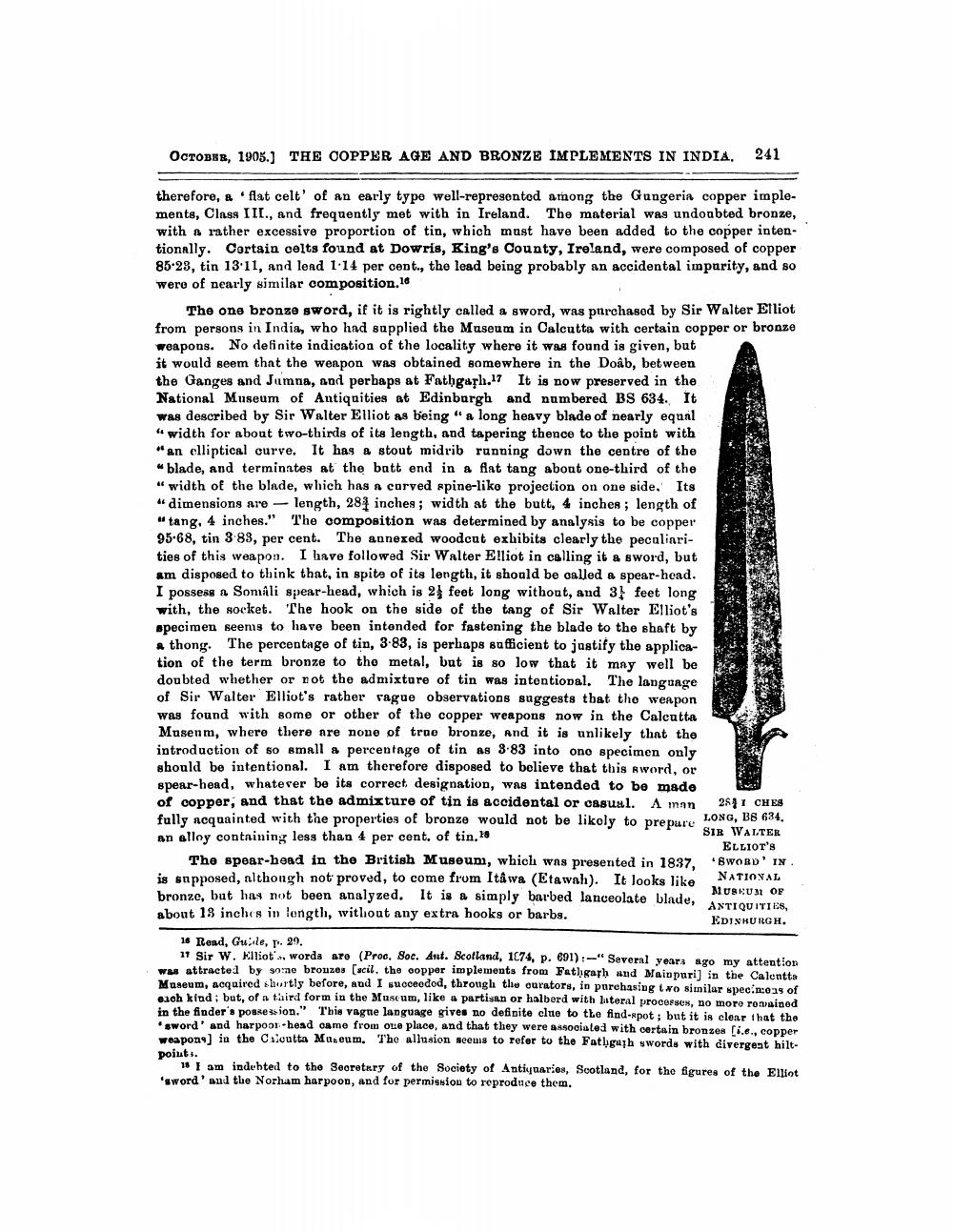________________
OCTOBER, 1905.) THE OOPPER AGE AND BRONZE IMPLEMENTS IN INDIA. 241
therefore, & flat celt' of an early type well-represented among the Gungeria copper implements, Class III., and frequently met with in Ireland. The material was undoubted bronze, with a rather excessive proportion of tin, which must have been added to the copper intentionally. Cortain colts found at Dowris, King's County, Ireland, were composed of copper 85-23, tin 13'11, and lead 1.14 per cent., the lead being probably an accidental impurity, and so were of nearly similar composition.
The one bronze sword, if it is rightly called a sword, was purchased by Sir Walter Elliot from persons in India, who had supplied the Museum in Calcutta with certain copper or bronze weapons. No definite indication of the locality where it was found is given, but it would seem that the weapon was obtained somewhere in the Doab, between the Ganges and Jumna, and perbaps at Fathgash.17 It is now preserved in the National Museum of Antiquities at Edinburgh and numbered BS 634. It was described by Sir Walter Elliot as being "a long heavy blade of nearly equal " width for about two-thirds of its length, and tapering thence to the point with "an elliptical curve. It has a stout midrib running down the centre of the "blade, and terminates at the batt end in a flat tang about one-third of the " width of the blade, which has a corved spine-liko projection on one side. Its "dimensions are - length, 284 inches; width at the butt, 4 inches ; length of "tang, 4 inches." The composition was determined by analysis to be copper 95-68, tin 3-83, per cent. The annexed woodcut exhibits clearly the peculiarities of this weapon. I have followed Sir Walter Elliot in calling it a sword, but am disposed to think that, in spite of its length, it should be called a spear-head. I possess a Somali spear-head, which is 2 feet long without, and 31 feet long with, the socket. The hook on the side of the tang of Sir Walter Elliot's specimen seems to have been intended for fastening the blade to the shaft by #thong. The percentage of tin, 3-83, is perhaps sufficient to justify the application of the term bronze to the metal, but is so low that it mny well be doubted whether or not the admixture of tin was intentional. The language of Sir Walter Elliot's rather rague observations suggests that the weapon was found with some or other of the copper weapons now in the Calcutta Musenm, where there are none of true bronze, and it is unlikely that the introduction of 50 small a percentage of tin as 8.83 into ono specimen only should be intentional. I am therefore disposed to bolieve that this word, or spear-hend, whatever be its correct, designation, was intended to be made of oopper, and that the admixture of tin is accidental or casual. A man 25 Y CHES fully acquainted with the properties of bronze would not be likely to prepure LONG, BS 634,
SIR WALTER an alloy containing less than 4 per cent. of tin. 10
ELLIOT'S The spear-head in the British Museum, which was presented in 1837 WORD IN. is supposed, althongh not proved, to come from Itåwa (Etawah). It looks like NATIONAL bronze, but has not been analyzed. It is a simply barbed lanceolate blade,
MUSEUM OF about 13 inches in longth, without any extra hooks or barbs.
EDISKURGH. 16 Read, Guide, T. 29.
11 Sir W. Elliot.. words aro (Proc. Soc. Ant. Scotland, 174, p. 691):-"Several years ago my attention was attracted by 9020 bronzes (ucil. the oopper implements from Fathgarh and Mainpuril in the Colentta Museum, acquired shortly before, and I succeodod, through the curators, in purchasing two similar spec.n029 of
h kind: but. of a third form in the Museum, like a partisan or halbord with lateral processes. no more romained in the finder's possession. This vague language gives no definite clute to the find-spotbut it is clear that the .word' and harpoon - head oame from one place, and that they were associated with certain bronzes Ci.e., copper weapony) in the soutta Museum. The allusion seems to refer to the Fathguh swords with divergent hiltpoints.
15 I am indebted to the Seoretary of the Society of Antiquarios, Scotland, for the figures of the Elliot 'sword and the Norham harpoon, and for permission to reproduce them.




